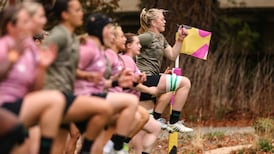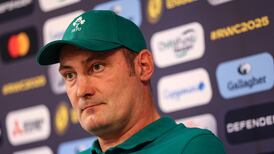World Rugby, formerly the International Rugby Board, is clear about head injuries. It says that if a player is suspected of having a head injury they should be taken off the pitch immediately.
In December 2013 the IRFU distributed a guide to educate players, coaches and parents with the catch phrase “Recognise and Remove. Stop. Inform. Rest. Return.”
Leaflets, posters and a road show went to schools and clubs with the support of a publicity campaign organised and funded by the IRFU and driven by Head of Medical Services Dr Rod McLoughlin.
Suspicion of a head injury by a referee, medical staff, a coach, or a parent is enough to trigger intervention and remove a player from the field of play as head injury can cause concussion.
A parent intervened in a Leinster schools game before Christmas and took a head-injured player, a relative, out of the match. The player was subsequently hospitalised with concussion.
There are a number of symptoms that can lead to having a suspicion that a player has a head injury.
The IRFU outline these in their Safe Rugby guidelines. Slow to get off the ground is one such reason to hold a suspicion. Lack of balance is another reason to hold a suspicion. There is a long list of symptoms that players can suffer and any one of them is reason to hold a suspicion.
Suspicion is the operative word because looking from the sidelines nobody really knows if a player has suffered a head injury, or, if they have incurred a concussion. Even at elite level incidents are missed.
St Michael’s played against Clongowes in the Leinster Schools Senior Cup on Sunday February 8th in Donnybrook Stadium.
In the closing minutes of the game St Michael’s take a lineout on the right touchline on the Clongowes 22, playing towards the Wesley end of the ground.
The ball is secured and taken in field by the St Michael’s players and they begin to form a rolling maul near the centre of the pitch. They inch inside Clongowes’ 22.
Number eight Max Deegan peels from the back of the maul, runs diagonally to his left and is tackled by Clongowes hooker and captain, John Molony, who is defending the fringe area.
Molony appears to make contact with the knee or leg of Deegan. After contact he falls sideways to his left and rolls on to his front.
He is slow to get to his feet and when he does so he begins to move back towards his own goal area.
As he moves towards his own goal there are no other players beside him. Molony’s legs appear to give way and he falls to the ground for a second time, and rolls on to his back.
Molony seems not to be ducking out of the way of the clearing kick from his team-mate or the pass back to the kicker. He is not in the line or impeding the pass or the clearing kick. The clearing kick goes in a different direction from where Molony is lying.
Play continues and from the Setanta Sports television footage, it is clear that the hooker stands up again and continues to play.
He can be seen going back into the line as the footage shows him – Molony is wearing red coloured tape around his head – running across the pitch following play.
The next camera shot is of the Clongowes hooker lying on his back in a different part of the pitch from where he had fallen the second time.
It is not shown in the footage if he fell for a third time after a tackle or if he chose to go to ground. When the camera cuts to the scene he is already on the ground and being attended to by a physiotherapist and the team doctor.
Molony plays on and Clongowes hold out St Michael’s in the final minutes of the match in an epic defensive display and victory.
There are a number of questions arising from the footage. Is there a suspicion that Molony suffered a head injury in the first tackle? Is there a suspicion that when he fell down a second time when there was nobody near him that the reason for that is that he may have been injured from the first tackle on St Michael’s number eight Deegan?
If the answer is yes to either of those questions, according to World Rugby and IRFU protocols, the player should have been removed from play.
Often these incidents appear differently in real-time from the sideline than they do with the benefit of video footage.
Equally it is possible that nobody on the sideline saw the first two incidents in question and subsequently treated Molony without knowledge of those incidents.
When contacted a spokesperson for Clongowes school said that the health of the child is always their priority and that the player was examined by two medical people.
That examination is evident from the television footage, where both medical personnel can be seen talking to the player who is on the ground in the third instance.
The Clongowes school spokesperson added that the player was “lucid, showed absolutely no symptoms of concussion and that they went through all the protocols at the time.
“There were no headaches, no nausea and he was checked after the game and checked again since then. All the protocols were applied.”
The spokesman added that the player was being kept away from rugby for the week.
Clongowes meet Belvedere College in the Leinster Schools Senior Cup semi-final on March 3rd in Donnybrook Stadium.










